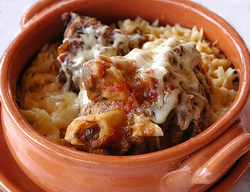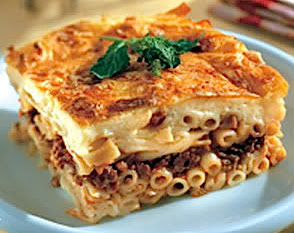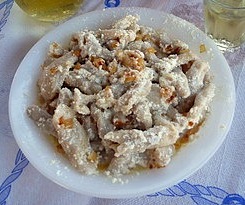Pastas of Greece & Karpathos

Some are made simply with durum-wheat semolina or flour, while more complex pastas have added eggs and/or dairy. Their flavorful versatility makes them staples in the Greek kouzina so we put together a guide of the most used zymarika, followed by in-store and online purchase options.
Pasta la Vista

Krithataki (κριθαράκι)
(pronounced kree-thah-RAH-kee) More commonly known as orzo, this rice-shaped pasta is made from durum-wheat semolina. Kritharaki is used in soups, like Avgolemono (Αυγολέμονο, pronounced ah-vyoh-LEH-moh-noh), in roasted meals with lamb, chicken or beef, and is especially known for being one of the main ingredients in the classic Giouvetsi/Youvetsi (Γιουβέτσι, pronounced yi-oo-VEH-tsee), a lamb-and-kritharaki dish with a light tomato sauce that’s baked in a clay casserole and topped with cheese. 
Hilopites (χυλοπίτες)
(pronounced hee-loh-PEE-tehs) Flat noodles that come in small squares and long wavy strands made with durum-wheat semolina, milk, and eggs. Hilopites are used in soups, stews, and casseroles, much in the same way kritharaki is used. Our mom used to add hilopites to a warm creamy sauce (think Fettuccine Alfredo), making this a winter favorite. 
Kofto (κοφτό)
(pronounced koh-FTOH) A short pasta (like tubetti) made from durum wheat semolina. Kofto, meaning cut, can also be used in place of kritharaki. Some like to use it for Pastitsio because it cooks quickly and layers easily, but once you cut the Pastitsio it can get sloppy, with the kofto spilling out, whereas the long pastitsio noodles would stay in place. 
Pastitsio No. 2 (παστίτσιο)
(pronounced pah-STEE-tsioh) This is very thick spaghetti with a hole down the center (like a straw) and is made from durum wheat semolina. The hole allows sauce to flow into the pasta. Pastitsio No. 2 pasta is layered with meat sauce and béchamel to make the classic Pastitsio dish, the Greek’s answer to lasagna. 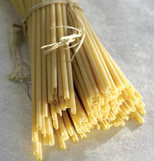
Macaroni No. 3 (μακαρόνια τρυπητά)
(pronounced mah-kah-ROH-niah tree-pee-TAH) This is macaroni with a hole (τρυπητά), a thinner version of Pastitsio No. 2, and is made from durum wheat semolina. Macaroni No. 3 is also used for Pastitsio when a finer pasta is desired. When serving Makaronada (Μακαρονάδα, pronounced mah-kah-roh-NAH-thah), pasta with an herbed meat sauce, many Greeks prefer a thicker pasta and use Macaroni No. 3 or Macaroni No. 5 (thick spaghetti without the hole). 
Makarounes (μακαρούνες)
(pronounced mah-kah-ROO-nehs) Karpathian handmade, flour-based pasta (similar to cavatelli). The dough is rolled with the fingertips, then cooked and plated with a topping of caramelized onion, olive oil, and myzithra cheese. Makarounes is an ancient peasant dish that is all the rave in today’s Karpathos. 
Fides (φιδές)
(pronounced fee-THEHS) Thin angel-hair pasta nests (like vermicelli) made from fine durum-wheat semolina, with several nests in one package. These easy-to-use nests go from package to soups, either whole or broken up. To serve as a first course, cook the nests individually in a basket to keep them intact, then drain and transfer, one at a time, to a large bowl. Toss with a fresh tomato sauce and chopped fresh parsley. Arrange each in a mound on serving plates and add a light drizzle of olive oil for an attractive presentation. 
Trahana(s) (τραχανά, τραχανάς)
(pronounced trah-hah-NAH) This traditional age-old pasta is handmade and resembles coarse bulgur. Trahana comes in two varieties, sweet and sour. Both are made with cracked wheat but the sweet, gliko (γλυκό, pronounced ylee-KOH), has whole milk added, while the sour, ksino (ξινό, pronounced ksi-NOH), is made with sour milk or yogurt. In Karpathos we call the sour version ksinohondros (ξινόχοντρος, pronounced ksee-NOH-hohn-trohs), ksino meaning sour and hondros meaning thick or fat chunks. The trahana mixture is cooked, shaped into triangles or rounds, and spread out on large sheets that are placed outside so the trahana can be sun dried. Once dry, it is then broken up and ready to store or to add to recipes. Trahana has been a staple in Greek kitchens for centuries and is considered one of the country’s most delicious foods. It is often added to side dishes and stews as an enhancement (when just a little is required), but it becomes the main ingredient in the recipe it’s best known for, Trahanosoupa (τραχανόσουπα, pronounced trah-hah-NOH-soo-pa), a thick trahana soup. 
Pourgouri / Pligouri (πουργούρι / πλιγούρι)
(pronounced poo-RYOO-ree / plee-YOO-ree) Bulgur wheat. Technically a grain, but we’re including pourgouri in this category because it is interchangeable with kritharaki, trahana, or kofto in a number of dishes. It makes soups, salads, and side dishes heartier, but it’s also cooked alone and served with yogurt. Pligouri Salata (πλιγούρι σαλάτα, pronounced plee-YOO-ree sah-LAH-tah), Bulgar Salad, is a toss of bulgur, herbs, cucumber, and tomato, which make it as visually appetizing as it is delicious. |
|
Got Misko?
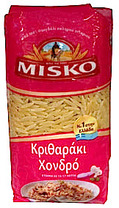
What’s Misko? It’s our favorite brand (and Greece's) for durum-wheat pastas. Misko always cooks up perfectly, firm but tender, and never mushy. We've tried others in a pinch and can say from experience, when you're making something special, this brand will never let you down.
For trahana we like Sitos brand, and for pourgouri, Lisko from Cyprus is our preference.
If you’re in the New York City area you can find these Greek pastas (and more) at the following markets:
Titan Foods
25-56 31st Street
LIC, N.Y, 11102
718-626-7771
Mediterranean Foods (2 locations)
22-78 35th Street
Astoria, NY 11105
718-721-0266
30-12 34th Street
Astoria, NY 11103
718-728-6166
If you don’t live near these markets but have a Greek Orthodox church nearby, chances are they know of a Greek/Mediterranean shop in the area.
Online shopping is the next best thing (or maybe the first). Here’s where you can find Greek pasta, as well as other foods and items:
Recipiada
Greek International Food Market
greekshops.com
Amazon
I hope you enjoyed Pasta Kouzina. These pastas will also be featured in recipes in our upcoming cookbook! Stay tuned for more uniquely Greek and Karpathian foods that you can add to your kouzina pantry.
Sign up for our e-newsletter (if you haven’t already) and stay connected on social media for cooking tips and recipes, as well as for all Kukla's Kouzina updates and news.
Thanks for following us and we’ll see you next Monday!
Until then~
Kali orexi! Good appetite!
Kelly
Web design by Kelly Salonica Staikopoulos

